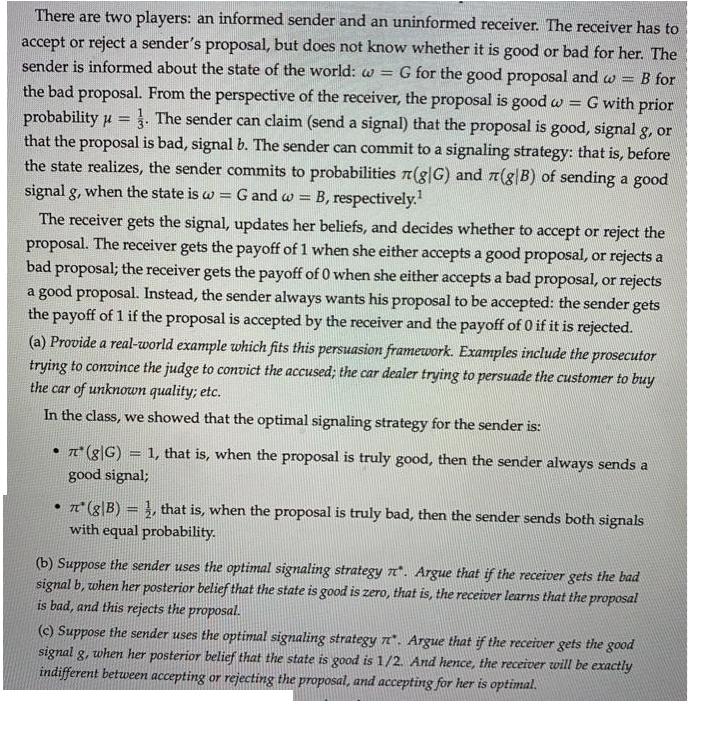Answered step by step
Verified Expert Solution
Question
1 Approved Answer
There are two players: an informed sender and an uninformed receiver. The receiver has to accept or reject a sender's proposal, but does not

There are two players: an informed sender and an uninformed receiver. The receiver has to accept or reject a sender's proposal, but does not know whether it is good or bad for her. The sender is informed about the state of the world: w = G for the good proposal and w= B for the bad proposal. From the perspective of the receiver, the proposal is good w = G with prior probability =3. The sender can claim (send a signal) that the proposal is good, signal g, or that the proposal is bad, signal b. The sender can commit to a signaling strategy: that is, before the state realizes, the sender commits to probabilities (g|G) and (g|B) of sending a good signal g, when the state is w = G and w = B, respectively. The receiver gets the signal, updates her beliefs, and decides whether to accept or reject the proposal. The receiver gets the payoff of 1 when she either accepts a good proposal, or rejects a bad proposal; the receiver gets the payoff of 0 when she either accepts a bad proposal, or rejects a good proposal. Instead, the sender always wants his proposal to be accepted: the sender gets the payoff of 1 if the proposal is accepted by the receiver and the payoff of 0 if it is rejected. (a) Provide a real-world example which fits this persuasion framework. Examples include the prosecutor trying to convince the judge to convict the accused; the car dealer trying to persuade the customer to buy the car of unknown quality, etc. In the class, we showed that the optimal signaling strategy for the sender is: (g|G) = 1, that is, when the proposal is truly good, then the sender always sends a good signal; . n* (g|B) = 1, that is, when the proposal is truly bad, then the sender sends both signals with equal probability. (b) Suppose the sender uses the optimal signaling strategy n. Argue that if the receiver gets the bad signal b, when her posterior belief that the state is good is zero, that is, the receiver learns that the proposal is bad, and this rejects the proposal. (c) Suppose the sender uses the optimal signaling strategy n. Argue that if the reco gets the good signal g, when her posterior belief that the state is good is 1/2. And hence, the receiver will be exactly indifferent between accepting or rejecting the proposal, and accepting for her is optimal. There are two players: an informed sender and an uninformed receiver. The receiver has to accept or reject a sender's proposal, but does not know whether it is good or bad for her. The sender is informed about the state of the world: w = G for the good proposal and w= B for the bad proposal. From the perspective of the receiver, the proposal is good w = G with prior probability =3. The sender can claim (send a signal) that the proposal is good, signal g, or that the proposal is bad, signal b. The sender can commit to a signaling strategy: that is, before the state realizes, the sender commits to probabilities (g|G) and (g|B) of sending a good signal g, when the state is w = G and w = B, respectively. The receiver gets the signal, updates her beliefs, and decides whether to accept or reject the proposal. The receiver gets the payoff of 1 when she either accepts a good proposal, or rejects a bad proposal; the receiver gets the payoff of 0 when she either accepts a bad proposal, or rejects a good proposal. Instead, the sender always wants his proposal to be accepted: the sender gets the payoff of 1 if the proposal is accepted by the receiver and the payoff of 0 if it is rejected. (a) Provide a real-world example which fits this persuasion framework. Examples include the prosecutor trying to convince the judge to convict the accused; the car dealer trying to persuade the customer to buy the car of unknown quality, etc. In the class, we showed that the optimal signaling strategy for the sender is: (g|G) = 1, that is, when the proposal is truly good, then the sender always sends a good signal; . n* (g|B) = 1, that is, when the proposal is truly bad, then the sender sends both signals with equal probability. (b) Suppose the sender uses the optimal signaling strategy n. Argue that if the receiver gets the bad signal b, when her posterior belief that the state is good is zero, that is, the receiver learns that the proposal is bad, and this rejects the proposal. (c) Suppose the sender uses the optimal signaling strategy n. Argue that if the reco gets the good signal g, when her posterior belief that the state is good is 1/2. And hence, the receiver will be exactly indifferent between accepting or rejecting the proposal, and accepting for her is optimal.
Step by Step Solution
★★★★★
3.38 Rating (154 Votes )
There are 3 Steps involved in it
Step: 1

Get Instant Access to Expert-Tailored Solutions
See step-by-step solutions with expert insights and AI powered tools for academic success
Step: 2

Step: 3

Ace Your Homework with AI
Get the answers you need in no time with our AI-driven, step-by-step assistance
Get Started


